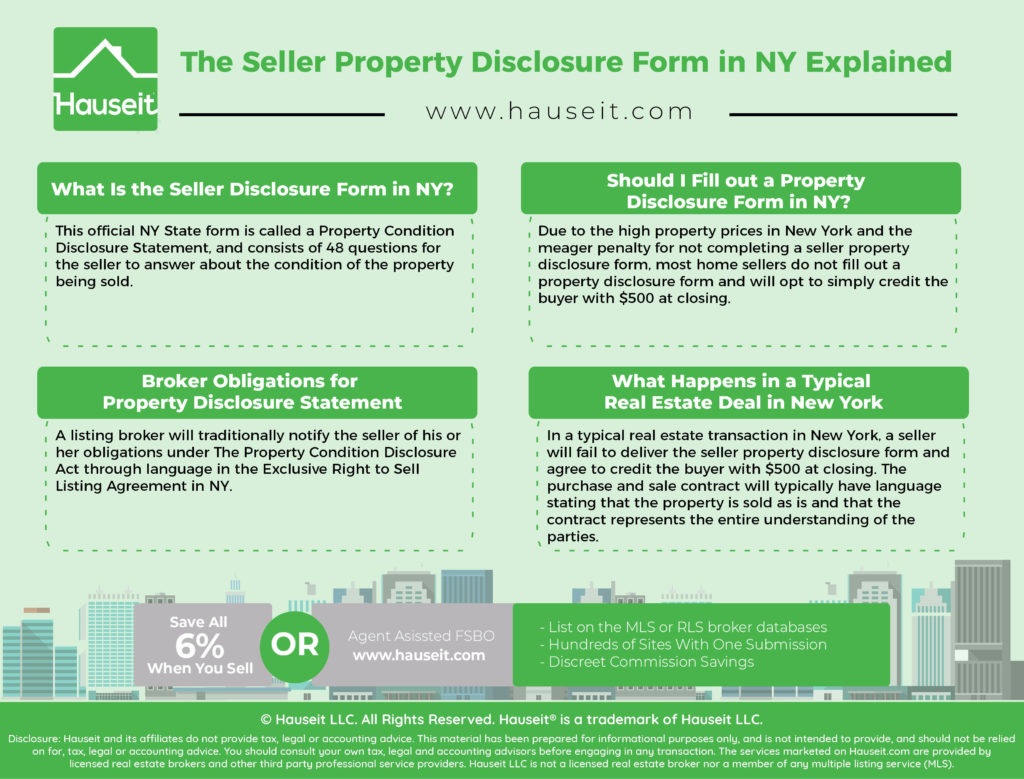New York laws are very friendly towards home sellers when it comes to property condition disclosures.
We’ll explain everything you need to know about the seller property disclosure form in NY in this article, from what it is to what sellers do in reality.
Table of Contents:

What Is the Seller Disclosure Form in NY?
This official NY State form is called a Property Condition Disclosure Statement, and consists of 48 questions for the seller to answer about the condition of the property being sold.
Sellers are instructed to complete the form themselves and to answer all questions based on their actual knowledge.
If a seller makes a knowingly false or incomplete statement on the form, a buyer may be able to make a claim against the seller even after the transfer of title.
With that said, the form acknowledges the principle of caveat emptor, or buyer beware, and says that the form is not a substitute for independent due diligence by the buyer, and that the form is not a warranty of any kind by the seller.
The penalty for not providing the buyer with a completed seller property disclosure form prior to the buyer signing a contract is a $500 credit against the purchase price to the buyer.
A Full Service Listing for 1%
Sell your home with a traditional full service listing for just one percent commission.
Should I Fill out a Property Disclosure Form in NY?
Due to the high property prices in New York and the meager penalty for not completing a seller property disclosure form, most home sellers do not fill out a property disclosure form and will opt to simply credit the buyer with $500 at closing.
Furthermore, most sellers are not engineers and they may not know the answer to all of the questions on the Property Condition Disclosure Statement. As a result, it’s often safer to credit the buyer with $500 vs risk a claim by the buyer down the road for misrepresentation.
How Would the Seller Know?
For example, one of the questions asks whether there any known material defects in the foundation or slab. How can the seller answer this?
What is a slab? How does the seller inspect the foundation to his or her house?
Here’s another one. Has the property ever been the site of a landfill? This is an open ended question. How far back do they want to go? How would the seller know the answer to this question? What if it was once a landfill one hundred years ago?
With that said, this is entirely a personal decision, and you should consult your real estate attorney on the matter. Perhaps you really want to save that $500 and you know all of the answers to the disclosure form and can back up your answers!
Broker Obligations for Property Disclosure Statement
A listing broker will traditionally notify the seller of his or her obligations under The Property Condition Disclosure Act through language in the Exclusive Right to Sell Listing Agreement in NY.
However, some listing brokers will ask the seller to sign a separate statement acknowledging that they have been advised of the seller’s obligations under the Real Property Condition Disclosure Law. Here is a sample statement that a real estate listing agent may ask a home seller to sign in New York:
Seller’s Obligations Under Real Property Condition Disclosure Law
Real Property Law § 463(2)
As the seller of residential real property, you are required by law to complete and sign a Property Condition Disclosure Statement as prescribed by Real Property Law § 462(2) and cause it, or a copy thereof, to be delivered to a buyer or buyer’s agent prior to the signing by the buyer of a binding contract of sale. A copy of the Property Condition Disclosure Statement containing the signature of both the buyer and the seller must be attached to the real estate purchase contract. If you acquire knowledge which renders materially inaccurate a Property Condition Disclosure Statement previously provided, you must deliver a revised Property Condition Disclosure Statement to the buyer as soon as practicable. In no event, however, will you be required to provide a revised Property Condition Disclosure Statement after the transfer of title from you to the buyer or after the buyer has commenced occupancy of the property. If you fail to deliver a Property Condition Disclosure Statement to the buyer prior to the buyer signing a binding contract of sale, the buyer will be entitled to a credit in the amount of $500 against the purchase price of the property upon the transfer of title.
The undersigned seller(s) acknowledge(s) that the broker named below has advised him/her/them of the foregoing obligations of seller(s) and that I (we) have read this form.
Get a 2% Rebate When You Buy
Save thousands on your home purchase with a buyer agent commission rebate from Hauseit
What Happens in a Typical Real Estate Deal in New York
In a typical real estate transaction in New York, a seller will fail to deliver the seller property disclosure form and agree to credit the buyer with $500 at closing.
The purchase and sale contract will typically have language stating that the property is sold as is and that the contract represents the entire understanding of the parties:
All prior oral or written representations, understandings and agreements had between the Parties with respect to the subject matter of this Contract are merged in this Contract, which alone fully and completely expresses the Parties’ agreement.
Furthermore, a standard rider to a purchase contract may include the following language:
Purchaser acknowledges that neither Seller nor any person purporting to act for Seller has made any representations as to physical condition, layout, size, square footage, income, taxes, expenses, school district, operation, maintenance, quality, condition or any other manner or thing affecting or relating to the Premises except as specifically set forth herein. The Seller shall not be liable or bound for any verbal or written statements, representations, real estate brokers’ set-ups or information pertaining to the above premises furnished by any real estate broker, agent, employee, servant or other person, unless the same is specifically set forth herein.
As you can see, the seller is essentially saying that they have made no representations about the property, and the purchase is entirely subject to caveat emptor. Because the seller makes no representations about the property, everything the buyer deduces about the property must come from the buyer’s own due diligence.
Save 2% On Your Home Purchase
Save thousands on your home purchase with a buyer agent commission rebate from Hauseit
Disclosure: Commissions are not set by law or any Realtor® association or MLS and are fully negotiable. No representation, guarantee or warranty of any kind is made regarding the completeness or accuracy of information provided. Square footage numbers are only estimates and should be independently verified. No legal, tax, financial or accounting advice provided.






